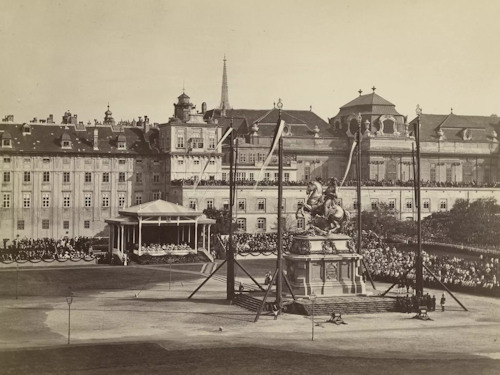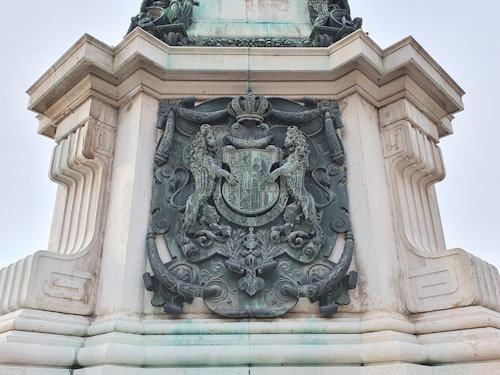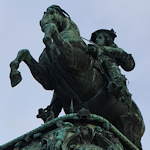Reminders of Prince Eugene of Savoy pepper Vienna, not least in the form of his former residence at the Belvedere palaces. The main monument to this military genius, who served three Habsburg emperors, sits on Heldenplatz square.
- Bronze equestrian statue on a giant plinth
- Unveiled in 1865 by Franz Joseph
- Book a themed guided tour* for Vienna
- See also:
A monument to a Frenchman?

(Eugene guards the entrance to the national library)
Heldenplatz square in the very centre of Vienna has two massive equestrian statues on it.
One honours the Habsburgs’ own Archduke Karl, notable for giving Napoleon a black eye at the 1809 Battle of Aspern-Essling.
The other honours the Paris-born Prince Eugene of Savoy (1663-1736).
France being notably not a dominion of any Habsburg, you might wonder why he deserved such an accolade.
Refused a command in the French military, a young Eugene popped across to Austria and offered his sword and brain to Emperor Leopold I, beginning his service at the lifting of the 1683 siege of Vienna.
To cut a long story short, Eugene rose rapidly through the ranks to eventually command armies, smite various foes, and establish himself as perhaps the Habsburgs’ most successful ever military leader.
(Although, to be honest, the Habsburg era is generally better remembered for the music, arts, architecture and politics rather than military renown.)
Eugene’s efforts on behalf of the Imperial court did not go unrewarded (he built the Belvedere and Schloss Hof palaces, for example, on the proceeds of Imperial gratitude). And, in 1865, further acknowledgment of his contributions came in the form of an equestrian monument.
The unveiling on October 18th, in the presence of Emperor Franz Joseph and Empress Elisabeth, coincided with Eugene’s 203rd birthday.

(A photograph of the unveiling taken by Julius Leth; Wien Museum Inv.-Nr. 9572/1; excerpt reproduced with permission under the terms of the CC0 licence)
The bronze statue owes its design to the sculptor, Anton Dominik Fernkorn: the man also responsible for that 1860 Archduke Karl monument.
The two statues were meant to complement one another, hence the similarities. Though Fernkorn seems to have made life a bit easier for himself with Eugene by having the prince’s horse anchored to the plinth by its tail as well as its hind legs.
Various inscriptions decorate the monument. These include the names and dates of notable battles involving Eugene, beginning with Zenta 1697 and ending with his 1717 capture of Belgrade from the Ottoman empire.

(Eugene’s family coat of arms on the rear of the monument)
The dedications on three sides of the statue are (all my rough translations):
- Front: The noble knight Prince Eugene (top) and Erected by Emperor Franz Joseph 1865 (below)
- To Eugene’s left: For the wise advisor to three emperors
- To Eugene’s right: For the glorious victor over Austria’s enemies
How to get to Eugene
See the main Heldenplatz article for travel advice, though you likely pass through it on any exploration of the old town.
Eugene’s monument is the one closest to the Neue Burg building that now provides a home for the National Library, the Weltmuseum, the Ephesos Museum, and the House of Austrian History.
Address: Heldenplatz, 1010 Vienna
